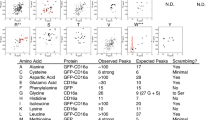Summary
Arginase (EC 3.5.3.1), the final enzyme in the urea cycle, catalyzes the cleavage of arginine to orthinine and urea. At least two forms of this enzyme, Al and All, have been described and are probably encoded by discrete genetic loci. The expression of these separate genes has been studied in mammalian cells grown in culture. The permanent rat-hepatoma line H4-II-E-C3 contained exclusively the Al enzyme; the form in mammals comprising about 98% of the arginase activity in liver and erythrocytes but catalyzing only about one half of that reaction in kidney, gastrointestinal tract, and brain. By contrast, human-embryonic-kidney and -brain cells, after transformation with the human papovavirus BK, contained only the All species of arginase, which form contributes the remaining half of that catalysis in those mammalian tissues in vivo. We report here the results of an extensive study on the properties of these two forms of arginase in the three cell lines, including Km values for arginine, behavior on polyacrylamide gels under non-denaturing conditions, and cross-reactivity with lapine antibodies against the arginases from either rat or human liver.[/p]
Similar content being viewed by others
References
Herzfeld A, Raper SM: The heterogeneity of arginases in rat tissues. Biochem J 153:469–478, 1976.
Ratner S, Morell H, Carvalho E: Enzymes of arginase metabolism in the brain. Arch Biochem Biophys 91:280–289, 1960.
Reddi PK, Knox WE, Herzfeld A: Types of arginases in rat tissues. Enzyme 20:305–310, 1975.
Glass RD, Knox WE: Arginase isozymes of rat mammary gland, liver, and other tissues. J Biol Chem 248:5785–5789, 1973.
Cederbaum SD, Shaw KNF, Valente M: Hyperargininemia. J Pediatr 90:569–573, 1977.
Cederbaum SD, Shaw KNF, Spector EB, Snodgrass PJ, Verity MA, Sugarman GI: Hyperargininemia due to arginase deficiency. Pediatr Res 13:827–833, 1979.
Walser M: Urea cycle disorders and other hereditary hyperammonemic syndromes. In: Stanbury JB, Wyngaarden JB, Frederickson DJ, Goldstein JL, Brown MS (eds), The Metabolic Basis of Inherited Diseases, 5th ed. McGraw-Hill, New York, 1983, pp 402–438.
Terheggen HG, Schwenk A, Lowenthal A, Van Sande M, Colombo JP: Hyperargininamie mit Arginasedefekt: eine neue familiare Stoffwechselstorung. I. Klinische Befunde. Z Kinderheilk 107:298–312, 1970.
Terheggen HG, Schwenk A, Lowenthal A, Van Sande M, Colombo JP: Hyperargininamie mit Arginasedefekt: eine neue familiare Stoffwechselstörung. II. Biochemische Untersuchungen. Z Kinderheilk 107:313–323, 1970.
Terheggen HG, Lowenthal A, Lavinha F, Colombo JP: Familial hyperargininemia. Arch Dis Child 50:57–62, 1975.
Snyderman SE, Sansaricq C, Cheu WJ, Norton PM, Phansalkar SV: Argininemia. J Pediatr 90:563–568, 1977.
Snyderman SE, Sansaricq C, Norton PM, Goldstein F: Argininemia treated from birth. J Pediatr 95:61–63, 1979.
Michels VV, Beaudet AL: Arginase deficiency in multiple tissues in argininemia. Clin Genet 13:61–67, 1978.
Qureshi IA, Letarte J, Ouellet R, Lelievre M, Laberge C: Ammonia metabolism in a family affected by hyperargininemia. Diabete et Metabolism (Paris) 7:5–11, 1981.
Spector EB, Rice SCH, Cederbaum SD: Immunologic studies of arginase in tissues of normal human adult and arginase-deficient patients. Pediatr Res 17:941–944, 1983.
Schimke RT: Studies on factors affecting the levels of urea cycle enzymes in rat liver. J Biol Chem 238:1012–1018, 1963.
Haggerty DF, Spector EB, Lynch M, Kern R, Frank LB, Cederbaum SD: Regulation by glucocorticoids of arginase and argininosuccinate synthetase in cultured rat hepatoma cells. J Biol Chem 257:2246–2253, 1982.
Linke HM: The interaction of the human polyomavirus BKV with malignantly transformed and persistently infected human fetal brain cells. Thesis. University of California, Los Angeles, 1981.
Purchio AF, Fareed GC: Transformation of human embryonic kidney cells by human papovavirus BK. J Virol 29:763–769, 1979.
Spector EB, Rice SCH, Moedjono S, Bernard B, Cederbaum S: Biochemical properties of arginase in human adult and fetal tissues. Biochem Med 28:165–175, 1982.
Spector EB, Kiernan M, Bernard B, Cederbaum SD: Comparative properties of fetal and adult red blood cell arginase: a possible prenatal diagnostic test for arginase deficiency. Am J Hum Genet 32:79–87, 1980.
Terasaki K, Spector EB, Hendrickson R, Cederbaum SD: Properties of arginases from liver of Macaca fascicularis: comparison of normals with red blood cell arginase deficient monkeys. Biochem Genet 18:829–841, 1980.
Kanalas JJ, Spector EB, Cederbaum SD: Hollow-fiber reactors containing mammalian arginase: an approach to enzyme replacement therapy. Biochem Med 27:46–55, 1982.
Laemmli UK: Cleavage of structural proteins during the assembly of the head of bacterophage T4. Nature 227:680–685, 1970.
Merril CR, Goldman D, Sedman S, Ebert MH: Ultrasensitive stain for proteins in polyacrylamide gels shows regional variations in cerebrospinal fluid proteins. Science 211:1437–1438, 1980.
Bradford MM: A rapid and sensitive method for the quantification of microgram quantities of proteins using the principle of protein dye binding. Anal Biochem 72:248–254, 1976.
Eisenthal R, Cornish-Bowdin AJ: Statistical considerations in the estimation of enzyme kinetic parameters by the direct linear plot and other methods. Biochem J 139:715–720, 1974.
Mamont PS, Bohlen P, McCann PP, Bey P, Schuber F, Turdif C: Alpha-methyl ornithine, a potent competitive inhibitor of ornithine decarboxylase, blocks proliferation of rat hepatoma cells in culture. Proc Natl Acad Sci USA 73:1626–1630, 1976.
Aperia A, Broberger O, Larsson A, Snellman D: Studies of renal urea cycle enzymes. I. Renal concentrating ability and urea cycle enzymes in the rat during protein deprivation. Scand J Clin Lab Invest 39:329–336, 1979.
Kaysen GA, Strecker HJ: Purification and properties of arginase in rat kidney. Biochem J 133:779–788, 1973.
Author information
Authors and Affiliations
Additional information
Presented in part at the annual meeting of the Society for Pediatric Research, Washington, D.C., May, 1982. Pediatr. Res. 16:195A.
Rights and permissions
About this article
Cite this article
Spector, E.B., Kern, R.M., Haggerty, D.F. et al. Differential expression of multiple forms of arginase in cultured cells. Mol Cell Biochem 66, 45–53 (1985). https://doi.org/10.1007/BF00231822
Received:
Issue Date:
DOI: https://doi.org/10.1007/BF00231822




